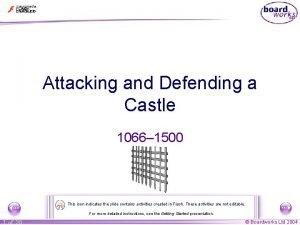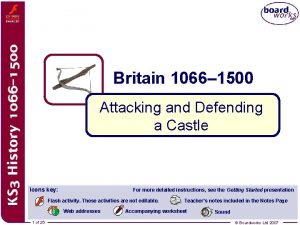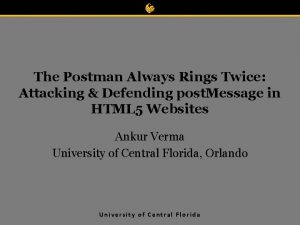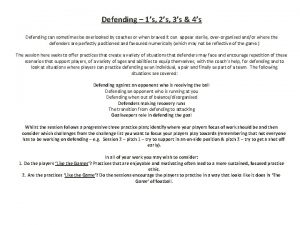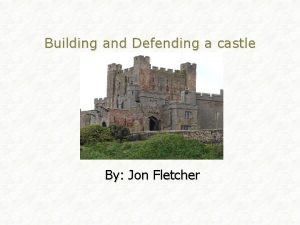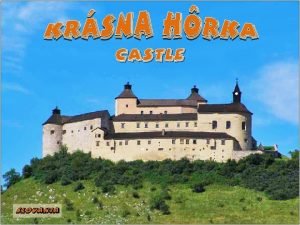My investigation into attacking and defending a castle

















- Slides: 17

My investigation into attacking and defending a castle

Group research • In your rows of four. • You will be researching ways in which castles defended themselves against attack. • Each member of the group will be given an information card. They will need to read this and then explain all they have discovered to the others in the group. • Record all your knowledge in your books neatly under the heading: How were castles defended against attack?

Defence - Blockading • Walls could be up to four metres thick. • Windows were rare; instead, slits called arrow slits were built for archers. • Those inside made sure they could be selfsufficient when cut off from the outside world by a siege. • They built wells and kept livestock inside their walls, guaranteeing fresh water and fresh meat during a siege. • They also salted foods such as bacon and fish and stored grains and beans by the barrel-full. • Castle garrisons also stockpiled weapons, for reinforcements often could not get through. • If a siege continued into winter, castle dwellers had more protection from the elements than attackers, and if their rations held up, also more BACK food to sustain them.

Defence - Archers • Archers shooting arrows from the castle had a great advantage. as they launching arrows from a higher position. • The castle wall also protected them well. • Arrow slits were often splayed to the inside, enabling archers to hide off to the side while reloading, giving them protection. • The most powerful was the crossbow. Barbs on the head of a bolt, were often coated with beeswax to help them pierce armour. • Crossbows took longer to load than the simple bow or the longbow. BACK • A longbow archer could shoot about 12 arrows in the time it took to launch a single bolt. • The longbow could send arrows as far as 1, 000 feet. • However, longbows took tremendous strength to shoot and much practice to control.

Defence - Gatehouse • The gatehouse, the castle's entrance, was the early castle's most vulnerable point. • A drawbridge could be pulled back, lifted, or pivoted like a see saw. • A portcullises—iron-covered wooden grills that moved up and down in front of the gatehouse door—provided additional protection. • Castle dwellers could also slide wooden beams behind the doors to reinforce. • If attackers entered the gate's passageway, they ran the risk of being trapped. By a second portcullis behind them. • Roofs above gate passages often had "murder holes" through which castle soldiers could drop burning oil, hot sand, or scalding water.

What have we learnt?

Attacking a castle! • http: //w ww. you tube. co m/watc h? v=Bt a. RI 1 U D 0 y 0

Attack - Direct Assault • A direct assault was the most dangerous way for attackers to try to take a castle. • Soldiers either scaled walls with ladders or overran castle walls breached by tunnels, battering rams, or artillery. • Sometimes they attacked two or three spots around the castle at once to surprise their foe or divide castle defences. • Defenders, perched on the castle wall had the upper hand. • Archers rained arrows down on attackers, while soldiers pushed ladders off the wall with forked poles, dropped rocks or firepots onto the attackers.

Group research • In your rows of four. • You will now be researching ways in which castles were attacked. • Each member of the group will be given an information card. They will need to read this and then explain all they have discovered to the others in the group. • Record all your knowledge in your books neatly under the heading: How were castles attacked?

Attack - Siege Tower • Attackers sometimes built a siege tower to scale castle walls. • Soldiers lay in wait inside the structure as others wheeled it to the castle. • Once there, the soldiers lowered a drawbridge at the top of the tower onto the castle wall. • Some towers were almost 100 feet high, and in the siege of Kenilworth Castle, fully 200 archers and 11 catapults were crowded into a single tower. • Siege towers were difficult and time-consuming to build. • To protect their siege engine, attackers draped it with rawhides of mules or oxen.

• They could launch missiles Attack hundreds of yards in large arcs at or over a wall. Trebuchet • The best fired stone missiles weighing up to 400 pounds. • Attackers also used them to launch dung or dead • animals into the castle with • During a siege, these the intention of spreading missile launchers were one disease. of the most fearsome weapons of medieval times. • Sometimes they even shot out the severed heads of enemy soldiers.

Attack - Battering Ram • Siege armies used a battering ram to break down a gatehouse door or even smash a castle wall. • To shield themselves from attack, they built a covered shed, in which they hung a thick tree trunk on chains suspended from a beam above. • Carpenters tapered the trunk into a blunt point and capped it with iron. • The slow forward movement as the battering ram was wheeled toward the castle wall earned it the nickname "tortoise. " • Soldiers swung the hanging trunk back and forth, and the forward end of the trunk moved in and out of the shed like a tortoise's head, battering its target.

Attack - Tunnelling • Men called sappers sometimes dug tunnels to gain entrance to a castle; launch a sneak attack. • Usually these miners dug tunnels beneath a castle wall to destabilize and topple it. • They supported their tunnels with timbers, which they then burned to collapse the tunnel and, hopefully, the wall above. • To defend themselves, castle dwellers put out a bowl of water and watched for ripples that might indicate digging.

Evaluation: How effective were castle defences? • Write the subheading above and underline it with a ruler. • Write a brief paragraph explaining what you believe to be the best aspect of a medieval castle’s defence. Ensure you explain why this aspect was so important. • Write a brief paragraph explaining which weapon of attack you think was the best and why.

Plenary - Attack and Defence: multiple-choice questions

Homework • Design your own medieval weapon to be used in attacking a castle. Label your diagram to clearly explain how it should work. • Extra: Go to History on the net and complete the quick quiz – I did it in 26 seconds. . . Can you beat me!!

Plenary - Attack and Defence: multiple-choice questions
 Attacking and defending castles
Attacking and defending castles Beltlining and blame are two face-attacking strategies.
Beltlining and blame are two face-attacking strategies. The attacking firm goes head-to-head with its competitor.
The attacking firm goes head-to-head with its competitor. Characteristics of skilled performance
Characteristics of skilled performance Chameleon attacking in dream
Chameleon attacking in dream Pandas
Pandas Example of attacking the motive fallacy
Example of attacking the motive fallacy Bloodborne pathogens attacking the liver are
Bloodborne pathogens attacking the liver are Why is it important to defend your faith
Why is it important to defend your faith Defending and non defining relative clauses
Defending and non defining relative clauses Analytical category bucket
Analytical category bucket According to atticus what is maycomb's usual disease
According to atticus what is maycomb's usual disease Self-defending infrastructure
Self-defending infrastructure Defending the faith verses
Defending the faith verses Reputation-defending antisocial
Reputation-defending antisocial Defending sola scriptura
Defending sola scriptura Cisco self defending network
Cisco self defending network Glass castle discussion questions by chapter
Glass castle discussion questions by chapter
